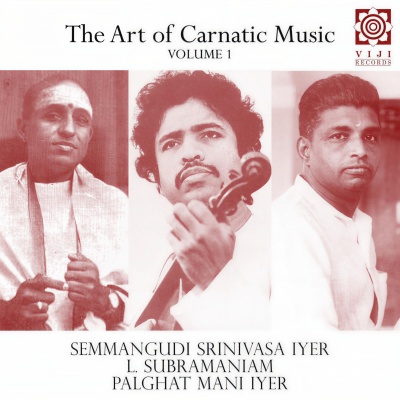
The Art of Carnatic Music, Vol. I
Semmangudi Srinivasa Iyer (1908-2003) grew up in the village of Semmangudi, Tanjavur district, the cradle of carnatic music. He had the opportunity to learn music under four distinguished musical stalwarts, including Semmangudi Narayaswamy Iyer, Tiruvidaimurudur Sakharama Rao, Umayalpuram Swaminatha Iyer and Maharajapuram Viswanatha Iyer. Although a traditionalist, he introduced many novelties in the works of composers ranging from Swati Tirunal to Ambujam Krishna. He also popularized rare ragas such as Bhavapriya, Salagabhairavi and Narayanagowla. He was showered with awards including the Padma Bhushan and the Padma Vibhushan conferred by the Government of India. Dr. L. Subramaniam, India's foremost violinist began learning the violin at a very young age from his father Prof. V. Lakshminarayana. His guru-shishya parampara can be traced back to the three greatest composers of the Carnatic music tradition - Shyama Shastry, Tyagaraja, and Muthuswami Dikshitar. He started performing Carnatic (South Indian classical) music at the age of six and soon gained immense popularity playing with his brothers in the Violin Trio. Even as a teenager he took a great interest in different forms of music and attained mastery over Western classical violin as well. Over the years, he has created the Global Fusion idiom and composed several crossover orchestral works but his primary focus has been Carnatic music. His mastery over technique, his sensitive musicianship and his intellectual innovations have enthralled audiences around the world. He has performed in all continents and is largely responsible for the international status that Carnatic music enjoys today. In his glittering career spanning over five decades, he has several innovations to his credit, including playing a varnam in 15 speeds, playing a pallavi in a rhythmic cycle of 21 3/4 beats, and improvising in pancha nadai (by dividing a beat into different pulses). Palghat T. S. Mani Iyer (1912–1981) was one of the greatest mridangam players of all time. He first studied with Palghat Subba Iyer, Kalpathy Viswanatha Iyer and later went on to learn from Thanjavur Vaidyanatha Iyer. Mani Iyer shot to fame after accompanying Chembai Vaidanatha Bagavathar in a music concert at Madras. With the arrival of Mani Iyer, there was a transformation of the role of the accompanying mrigandam player in a concert. He started the now prevalent trend of the mridangam, not just keeping the time with simple moras, but actively accompanying the musical phrasing, reproducing on the mridangam all the subtleties and rhythmic complexities of the musical composition. Most of the great mridangam players after his time were his students at one time or another. He was awarded the Sangeetha Kalanidhi by the Madras Music Academy and the Padma Bhushan by the Government of India. Semmangudi Srinivasa Iyer starts the album with "Vallabha nayakasya", a short composition of Muthuswami Dikshitar in the raga Begade set to Rupaka tala. The second piece is a very popular composition of Saint Tyagaraja in the raga Sriranjani set to Adi tala: "Brochevarevare". Next is Muthuswami Dikshitar's "Divaakara tanujam shanaishvaram", a kriti which is a part of his famous navagraha kritis series. This composition in the raga Yadukula Kambhoji set to Chatushra Eka tala of four beats is in praise of lord Shaneeshwara, the embodiment of the planet Saturn and deity of the seventh day in the Indian calendar, Saturday. The final piece is "Kamakshi", the marvellous svarajati of Shyama Shastry in the raga Bhairavi set to Misra Chapu tala of 7 beats. Srinivasa Iyer starts off with a short raga alapana (free style improvisation) followed by Dr. Subramaniam on the violin. Then he starts singing the composition where is joined by Dr. Subramaniam and Mani Iyer. In the later part of the composition, he performs a neraval (literally "spreading out") which is one of the improvisational methods in Carnatic music where a single line is taken (in this case "Shyamakrishna sahodari shivasankari parameshwari") and is elaborated using several variations. After the neraval, he sings kalpanasvaras (improvisation using solfege notation) before concluding. This is the first of The Art of Carnatic Music series.
